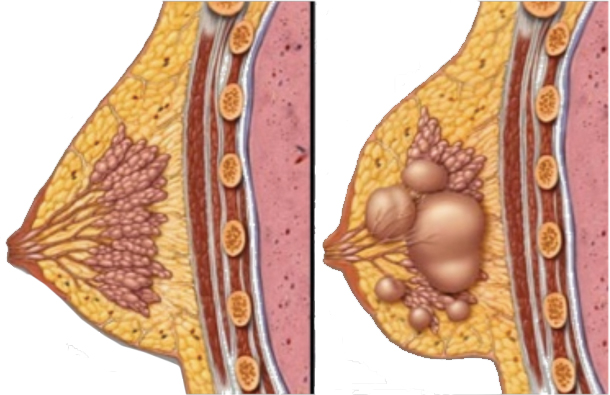**The information contained here is for educational purposes or to answer questions you may have about fibrocystic breast changes. If you discover a lump in your breast, or have a discharge from a nipple, you should contact your physician.
 What Is Fibrocystic Breast Disease?
What Is Fibrocystic Breast Disease?
Fibrocystic breast disease is a benign condition of the breast which affects about 60% of women during their childbearing years, especially between the ages of 30 to 50.
What Causes Fibrocystic Breast Disease?
The breasts are made up of fat, fibrous tissue and milk producing glands. The glands are linked by thin tubes called ducts. Each month in response to estrogen and progesterone released by the ovaries the milk glands and ducts enlarge and the breasts retain water. The breasts may feel swollen, lumpy and tender. After menstruation the breasts feel less tender and lumpy.
As this hormonal stimulation continues repeatedly, pockets of fluid called cysts may form and the breast tissue increases in firmness. The tissue may feel “ropey” on exam. These are fibrocystic changes.
What Are the Symptoms of Fibrocystic Breast Disease?
Symptoms may include:
- Breasts which feel dense, irregular and bumpy, especially in the outer quadrants
- Breast pain that may come and go, or be persistent
- Breasts which feel heavy and full
- Breasts which are painful and swollen prior to a period and improves after the menstrual cycle
- Increase in nipple sensation
How are symptoms relieved?
- Avoid caffeine (coffee, tea, cola, chocolate) for a few months
- Over the counter NSAIDS (Advil, Motrin, Aleve, etc.)
- 400 IU of Vitamin E daily in divided doses
- Decrease salt intake, especially the week before menstruation
- In severe cases, oral contraceptives can help
- When to call the physician?
New lump
- Existing lump increases in size or doesn’t go away with menstruation
- A distinct lump, rather than a lumpy area
- A change in breast size
Will a Monthly Breast Self Exam Help?
Performing a monthly breast self exam will help you become aware of what your breasts normally feel like so you can identify a change. Any new lump should be checked by your physician.
The best time to perform the breast self exam is in the first 7 to 10 days after the beginning of your period before the breasts begin to swell.